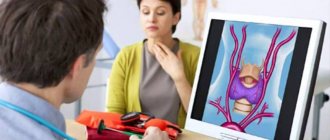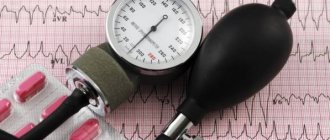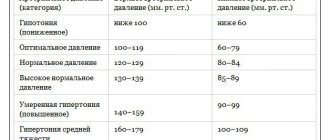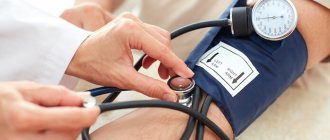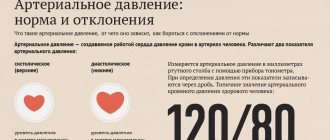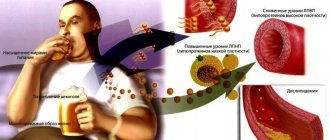A blood pressure of 130 over 100 is probably not very outside the generally accepted norm of indicators - 120 over 80, but many make the mistake of not paying due attention to this. If blood pressure (BP) is consistently above average, then most often it is hypertension.
The disease is dangerous because in the first stages it does not develop noticeably in the body. Often the disease is discovered by chance during a routine examination or during measurements on a personal tonometer. What are the causes of such pressure disorders, what to do if you are diagnosed with hypertension?
Is this a normal indicator?
When assessing the adequacy of blood pressure levels, it is necessary to take into account a lot of factors: weight, height, physical development, individual congenital and acquired characteristics of the patient’s body, the presence or absence of somatic diseases, and finally, a constant, “working” blood pressure indicator. These are important conditions.
It is impossible to say offhand whether a blood pressure level of 130/100 is normal. It's like trying to determine the average temperature in a hospital.
The usual level of pressure plays a significant role in the assessment process. Thus, hypotensive patients endure even 130 much more severely than patients of other profiles.
The following factors should be considered in more detail:
- Body mass. The larger it is, the higher the likelihood of an abnormality of such a phenomenon. Obese people suffer from hypertension, including isolated hypertension, much more often than their slender “brothers”.
- Height. Plays the same role. Both indicators are taken into account together.
- Physical development. For obvious reasons, people with more muscle volume suffer from arterial hypertension more often. In a sense, this is due to the use of anabolic drugs if the patient is involved in strength sports or correction of his own figure.
- Hormonal state. Peak moments always cause surges in blood pressure. Hemodynamic types of hypertension can be different. Among the likely factors: puberty (puberty), menstrual cycle (but not always), pregnancy (the most dangerous moment, you need to constantly monitor your well-being so as not to miss eclampsia), menopause or menopause in men. In this situation, correction is possible with the help of hormonal drugs or selective antihypertensive drugs.
- Climatic conditions. Hemodynamically isolated hypertension is more likely to develop in patients living in cold environments. Southern latitudes are more associated with a decrease in blood pressure, which is associated with innate adaptation. People who change conditions undergo acclimatization. This is a complex process, accompanied by deterioration in well-being and surges in blood pressure. Everything could end badly. Therefore, moving to hot regions if you have problems with the cardiovascular system is not recommended.
Often it comes down to a number of factors. Pressure 130 to 100 may increase for physiological reasons described. In such a situation, everything returns to normal by itself, without outside help.
But pregnant women and teenagers are recommended to regularly “visit” a cardiologist for preventive examinations.
How to normalize blood pressure 130/100 and above
If the pressure jumped to 130 to 100, what should you do and how to bring it down? First of all, you should not uncontrollably drink any drugs with a hypotensive effect. Exceeding the dose of medication leads to a strong decrease in blood pressure, and incorrect selection of the drug will lead to other dangerous consequences.
When the tonometer has recorded a pressure of 130/100, the following treatment methods are used to normalize it:
- Lifestyle changes.
- Folk recipes.
- Drug therapy.
A radical change in lifestyle
When hypertension manifests itself with a pressure of 130 over 100, it is important that the patient reconsider his life habits towards a healthy lifestyle:
- Perform physical activity as much as your health allows.
- Avoid sedentary activity.
- Walk outdoors every day.
- Normalize body weight (for obesity).
- Avoid excessive consumption of salt and foods containing it.
- Night sleep should not be less than 8 hours.
- Drink the recommended daily amount of fluid.
- Eliminate bad habits (smoking, alcohol, etc.).
- Maintain psychological comfort (stressful situations lead to surges in blood pressure).
A single surge in pressure can be eliminated by proper rest. You can take a non-hot bath with sea salt and get a massage.
Folk recipes
Treatment of hypertension with medicinal plants gives good results, a particularly stable positive effect is observed in the initial stages of the disease.
When lower blood pressure jumps, alternative medicine suggests taking decoctions and infusions of herbs that have a sedative and hypotensive effect.
The following folk recipes show sustained effectiveness for isolated hypertension:
| Means | Recipe and application |
| Peony decoction | For 1 tbsp. dried flowers of the plant will require 200 ml of boiling water. Place on the fire, bring to a boil, but do not boil. Leave under closed lid and filter. Take 1 tsp. 3 times a day before meals. |
| Herbal collection | You will need 2 tbsp. oregano and St. John's wort, 1 tbsp. sage and 5 tbsp. motherwort. Mix dry herbs, chop, measure 2 tbsp. mixture and pour 400 ml of hot water. Leave for 20 minutes. Take 50 ml 3 times a day on an empty stomach. |
| Motherwort infusion | For 400 ml of boiling water, take 2 tbsp. motherwort. Leave for 30 minutes, strain, drink 1 tbsp. 4 times a day. |
| Lingonberry juice with honey | 0.5 cups of fresh berries, grind, squeeze out the juice and add water in a 1:1 ratio, add a little honey. Take 3 times a day after meals. |
| Valerian infusion | Measure out 1 tbsp. crushed grass roots, place in a thermos, pour in 200 ml of boiling water. Leave for 8 hours and consume 1 tbsp. 3 times a day after meals. |
Treatment with drugs
Is it possible not to take medications if blood pressure has risen to 130/100 and continues to increase further, while the cause of the jump is unknown, but the patient feels quite normal? Experts say that in this case it is better to abstain from pills and mixtures until the factor that led to this condition is established, but blood pressure needs to be lowered. Prolonged high blood pressure negatively affects cardiac activity.
If lifestyle correction and herbal medicine do not give the expected result, the doctor prescribes medications. What kind of drugs will have to treat the pathological condition depends on what is causing the jump in blood pressure. Complex therapy is usually prescribed:
| Medicines by group | Name |
| ACE inhibitors | Enap. Kapoten. Trandorapril. Fosinopril. |
| Alpha blockers | Cordura. Tonocardin. Doxazosin. |
| Diuretics | Pterofen. Triampur. Indapamide. Amiloride. Hypothiazide. Furosemide. Triamterene. Chlorthalidone. Spironolactone. |
| Calcium channel blockers | Nimodipine. Nifedipine. Felodipine. Diltiazem. Verapamil. Lercanidipine. |
| Beta blockers | Carvedilol. Nadolol. Metoprolol. Esmolol. Nebivolol. Penbutolol. |
| Sartans | Irbesartan. Losartan. Telmisartan. Eprosartan. |
| Statins (normalize cholesterol levels) | Lovastatin. Simvastatin. Pitavastatin. |
| Sedatives | Nervoflux. Nobrassite. Gelarium Hypericum. |
As practice shows, with a pressure of 130 over 100 or more, the patient often experiences migraines. If your head starts to hurt, then you cannot tolerate a migraine; to relieve it, you should take:
- Sumamigrain.
- Nimesil.
Causes of increased lower pressure
The diastolic level rises in isolation quite rarely. In 70% of cases this is an indication of a pathogenic process. What kind - the doctors will find out.
An approximate list of pathological conditions looks like this:
- IBS. A chronic, minimal disruption of myocardial nutrition occurs. As a result, the nature of blood release changes, tissues do not receive enough necessary substances and oxygen (read more about coronary heart disease in this article.).
The sinus node, other cardiac structures, the brain and trunk, and the hypothalamus are affected. That is, all centers for regulating vascular tone. Chaotic signals lead to disturbances in blood pressure levels.
- Myocardial infarction and subsequent cardiosclerosis. They go hand in hand. The first determines the second. A complex phenomenon is necrosis of cardiomyocyte cells and their replacement with scar and connective tissue. The functional activity of the heart decreases, the normal functioning of all systems is disrupted. Without treatment, relapse and death are likely over a period of 1-3 years or less.
- Congenital and acquired malformations of cardiac structures. They do not manifest themselves in almost any way, which is due to the characteristics of the violations. Timely diagnosis is required. Treatment is mainly surgical.
- Problems with the nervous system. Including those induced due to stroke, encephalopathy, osteochondrosis and vertebrobasilar syndrome.
Diagnostics is carried out in a complex manner, using several techniques. Under the supervision of a neurologist. All processes of this kind are related by the clinical picture: headache, vertigo, focal problems occur: speech impairment, coordination, hearing, vision. Up to the complete loss of individual functions.
A stroke can be fatal in the short term or cause severe disability. The remaining phenomena are considered intermediate on the path to acute ischemia of cerebral structures.
- Hypercorticism. Excessive synthesis of adrenal hormones, especially cortisol. It develops as a primary process against the background of tumors, as well as neoplasia in the area of the hypothalamus and pituitary gland (corticotropinoma is the main cause).
The main clinical variant of the pathological process is Itsenko-Cushing syndrome. This is a dangerous, serious disease during which the patient gains weight uncontrollably. The musculoskeletal system and cardiovascular system are destroyed under the influence of hormonal substances.
- Hyperthyroidism. A more common variant that develops in patients of all ages. It manifests itself against the background of thyroid cancer, benign neoplasia, or trauma. Less often, poor nutrition. Correction is surgical and medicinal (in combination). Under the supervision of an endocrinologist.
- Liver problems. Of different nature. From hepatitis of viral or toxic origin to cirrhosis, which causes hemodynamic disturbances to a greater extent.
Against the background of pathologies of the described type, blood pressure is 130-135 per 100 - the result of a violation of the synthesis of angiotensinogen, a prehormone necessary for the production of a complete metabolite responsible for the regulation of vascular tone.
It is impossible to predict in advance how such a deviation will end. Various hemodynamic disturbances are possible: from persistent hypotension to the opposite phenomenon.
- Pathologies of the excretory system. In particular the kidneys. Delayed evacuation of water from the body, as a result of filtration dysfunction.
Another factor is a change in the nature of the synthesis of prehormone renin, which, along with angiotensin II and aldosterone, regulates vascular tone and generalized hemodynamics.
Possible problems include: pyelonephritis, insufficiency, and other phenomena. All pathological processes can cause blood pressure of 130/100 mm Hg. Art. and one way or another, the symptoms are the same: pain in the lower back, urination disorders (copious and frequent, or false urges to visit the toilet for no apparent reason).
Subjective aspects that are controlled by the patient also have an impact. Smoking provokes vasoconstriction at a general level, and a violation of blood pressure becomes a natural result.
Alcoholism is defined in the same way, only the effect is much stronger and occurs faster; for some patients, one glass or glass is enough to disrupt hemodynamics. A hypertensive crisis and even a stroke are possible.
Poor nutrition, stress, lack of sleep. All these factors are corrected as part of treatment and prevention.
The causes of pressure 130 to 100 are noted from the cardiovascular, excretory, endocrine or nervous systems. The assessment is carried out by a cardiologist in tandem with other specialists.
Symptoms
A small difference between systolic and diastolic blood pressure is called diastolic hypertension. The pathology is accompanied by the development of certain symptoms. But almost all manifestations of the condition are nonspecific and are attributed to ordinary fatigue.
Many patients learn about their problem only at an appointment with a therapist during a routine examination or treatment for another reason. There are a number of symptoms that make it possible to diagnose the disease at the very beginning of its development.
These include:
Blood pressure self-monitoring diary
- dizziness;
- noise in ears;
- mild nausea;
- headaches that get worse even after minor physical activity;
- increased heart rate;
- general discomfort;
- aching pain behind the sternum;
- fainting and pre-syncope;
- sleep disorders;
- nosebleeds;
- black dots flashing before the eyes.
One of the accompanying conditions of blood pressure 130 per 100 is dizziness
The appearance of such symptoms is a reason to contact your doctor - a cardiologist or therapist - for advice. Quite often the blood pressure is 130/100 mmHg. accompanied by rapid heartbeat. The pulse rises to 100 beats per minute and above. This indicates the development of tachycardia.
If the condition is triggered by stress or fear, that is, it is temporary, then it does not need treatment. If the heart rate regularly increases, a person needs to receive adequate treatment.
Important! In some cases, diastolic hypertension is accompanied by bradycardia. The pulse drops to 50 or less beats per minute.
Pulse value
There is no direct and immediate connection between blood pressure and heart rate. Both levels are established according to different rules and mechanisms.
Thus, cardiac structures are characterized by automaticity: the electrical impulse is generated by the sinus node (pacemaker) and is repeated spontaneously, since cardiomyocytes are capable of spontaneous excitation.
Heart rate is slightly adjusted by external factors. Blood pressure levels are regulated by the brain (cerebral stem, hypothalamus) and endocrine organs.
However, isolated arterial hypertension is often accompanied by tachycardia (pulse 100 or higher - sinus or paroxysmal variety). Bradycardia (pulse less than 60 beats per minute) is characteristic to a lesser extent.
In such a situation there is no contradiction. Simply, both the increase in diastolic indicator and the acceleration/deceleration of heart rate are determined by the same factor. A single etiology leads to the need for complex treatment. Identical methods can be used to correct both conditions.
Reasons for the lower score of 100
If high lower pressure is observed during numerous measurements, and the systolic indicator remains normal, we speak of isolated hypertension. The disease requires additional diagnostics and an individual treatment regimen.
Any therapeutic effect must be justified by the root cause of the underlying pathology. Increased lower blood pressure can be caused by:
- dysfunction of the kidneys and adrenal glands;
- hormonal imbalance in endocrine diseases;
- pathology of regulatory centers in the brain;
- abnormal structure of the spine, its hereditary or acquired deformation;
- cardiovascular diseases;
- genetic predisposition to high blood pressure;
- oncological diseases and benign tumor processes.
Isolated diastolic pressure increases not only against the background of pathological processes. Its increase to a value of 110 or more mmHg. may be a consequence of exposure to unfavorable external factors:
- stressful situations and severe emotional shock;
- insufficient rest, lack of proper sleep;
- alcohol abuse, smoking;
- irrational nutrition, consumption of fast food and foods with excessive salt or saturated fat;
- consumption of energy drinks and other stimulating drinks.
The doctor determines the physiological and pathological causes of high lower pressure during a detailed history taking and diagnostic measures.
What can you take at home?
You can do little on your own. Since blood pressure is unstable, the upper reading is normal, the lower reading is elevated, selective action on the root cause of the condition and symptomatic manifestations is required.
An approximate algorithm is as follows:
- Measure objective indicators: heart rate and blood pressure. If the gap grows over a short period of time, you should urgently consult a doctor; you should not rely on self-medication. In other cases, you can resort to the next point.
- Take 1/4 Captopril tablet.
- Take calcium antagonists (1 tablet of Diltiazem or Verapamil). Exceeding dosages and taking unspecified medications is strictly prohibited. It’s impossible to say in advance what this will lead to. But this does not bode well.
- Sedatives based on motherwort or valerian will help. Just not in the form of an alcohol tincture. Ethanol excites the nervous system, increasing blood pressure and heart rate.
- Take phenobarbital. Pharmaceutical forms - Corvalol, Valocordin. They calm the body and have a positive effect on the heart. The mild action explains the possibility of independent use.
- Open a window or vent to ensure a flow of fresh air into the room or space. This will improve your well-being.
Now you need to lie down and observe the symptoms. If everything is done correctly, the condition will most likely return to normal. Monitoring is carried out using an automatic tonometer.
If there is no effect, you should not continue amateur activities. Especially if the condition worsens. It is necessary to call an ambulance. Before the brigade arrives, you should rest and not make sudden movements.
What you should never do:
- Showers, hot and cold baths are contraindicated.
- You can’t do physical exercise, no mechanical activity.
- You should not consume drugs in the second round. Capoten does not reduce blood pressure selectively, so a drop in the upper reading will lead to hypotension. If the level is reduced sharply, a stroke or heart attack is possible.
It is also not recommended to neglect the presented combination of medications. It allows you to keep systolic numbers at the same level.
What symptoms should you consult a doctor for?
If there is a disturbance in well-being, there is not much difference. Even if there is suspicion, it is necessary to go to a cardiologist.
Among the manifestations that should alert you:
- Headache of unknown origin. Especially against the backdrop of general well-being.
- Vertigo. Up to the complete lack of coordination and orientation in space.
- Dyspnea. As a result of hypoxia of tissues and organs. It occurs spontaneously, even in a state of complete rest.
- Weakness, drowsiness.
- Feeling of heartbeat. It can be either accelerated or slowed down.
As a rule, the clinical picture is minimal. Due to the mildness of the pathological process, symptoms go unnoticed, patients rarely pay attention to their own condition.
The following signs are much more dangerous:
- Acute headache. It pokes and shoots. Painful, unbearable.
- Loss of consciousness.
- Speech, auditory, visual dysfunction.
- Problems with motor activity and obedience of muscle structures. Paralysis, paresis. Feeling of goosebumps running through the body.
These symptoms require an urgent call to the emergency room. The issue of hospitalization is being decided.
Symptoms of high blood pressure
If, when measuring blood pressure parameters, they show minor deviations from the norm, then there is no need to panic. Regular deviations in blood pressure measurements should be a cause for concern if they are accompanied by the following symptoms:
- constant headaches;
- the nose often bleeds;
- darkens in the eyes. So-called floaters and flickering appear before the eyes;
- nauseated;
- dizzy;
- discomfort in the heart area.
The listed symptoms may be the beginning of developing hypertension, or another serious pathology.
Diagnostics
Measures to identify the process itself and its “origins” fall on the cardiologist. Due to need, multidisciplinary specialists may be involved (which is most often the case), depending on the expected nature of the problem.
List of studies:
- Assessing the patient's complaints, their duration, duration and intensity.
- Anamnesis collection. Including family. Bad habits, lifestyle and other factors are of great importance.
- Measuring blood pressure on both arms at intervals of several minutes. Also on your feet.
- Daily Holter monitoring using an automatic programmable tonometer. Makes it possible to study not only blood pressure, but also heart rate.
- Electrocardiography.
- Echocardiography. An ultrasound method for assessing cardiac structures to identify defects, hypertrophy, and organic changes.
- Ultrasound of the kidneys.
- Blood test (general, biochemistry, hormones of the pituitary gland, adrenal cortex and thyroid gland).
- Clinical examination of urine.
- Assessment of neurological status using special tests.
At the discretion of specialists, the following are indicated: angiography, radioisotope examination of organs, CT, MRI (if a tumor is suspected, there are no alternatives to them).
What should I do to measure blood pressure correctly?
To measure blood pressure correctly, doctors adhere to strict rules. In addition to blood pressure, the patient's pulse can be measured. A tonometer is used to measure blood pressure. You need to make sure that the cuff of the device matches the volume of your arm, otherwise there will be incorrect readings. Measurements are taken after the patient rests for five minutes so that his condition returns to normal. At the same time, the room should have a comfortable temperature, because cold contributes to vasospasm and increased blood pressure.
If the patient smoked, ate or drank coffee, then the measurement is carried out no earlier than half an hour later. During the measurement process, the person should sit leaning on the back of a chair, with their legs and arms relaxed and not crossed. You can measure again after a couple of minutes. More accurate results are obtained with two measurements. In case of arterial hypertension, measurements are carried out twice a day - in the morning and evening, as well as when feeling unwell. If measurements are taken at home, the results are recorded and then shown to the doctor.
Therapeutic tactics
To a greater extent it is represented by non-medicinal methods. Among the ways to restore normal life.
Use of drugs:
- Calcium antagonists. Verapamil, Diltiazem.
- Beta blockers. Carvedilol, Anaprilin.
- Sedatives of plant origin. Motherwort and valerian.
- If the condition worsens, use ACE inhibitors (Perineva, Prestarium).
The main burden of the treatment process falls not on medication, but on lifestyle changes according to the following rules:
- Quitting smoking and alcohol.
- Normalization of sleep (8 hours per night, no less).
- Walks during the day (approximately 2 hours).
- Limit salt (7 grams).
- Drinking regime (1.8-2 liters).
Diet correction.
Can:
- Vegetables and fruits, prepared and raw.
- Dairy products.
- Butter.
- Nuts, seeds.
- Boiled eggs.
- Natural sweets.
- Dried fruits.
- Lean meat and broths based on it.
It is forbidden:
- Roast.
- Smoked.
- Salty.
- Semi-finished and canned foods.
- I'll bake it.
- Salo.
In general, the diet should be balanced. Treatment tables No. 3 and No. 10 are shown. Menu adjustments are carried out under the supervision of a nutritionist.
In the absence of the opportunity to consult, you should independently and roughly optimize your diet. Cooking method: boiling or baking. Minimum heat treatment.
Fractionality is another important principle. The frequency of meals is 4-6 times a day.
An important point is the refusal to independently use drugs, from contraceptives to antihypertensive drugs.
Surgical methods are used extremely rarely, only after destruction of the atria due to endocarditis or congenital, acquired defects. Installation of an artificial pacemaker is also possible.
Drug treatment
Treatment should be started when any signs of isolated diastolic hypertension are detected, confirmed by tonometer readings. Any medications can be taken only at the discretion of the doctor. Therapy is prescribed based on an examination of the patient, his individual indicators and characteristics of the body.
For the drug treatment of hypertension, the following are used:
- ACE inhibitors - Capoten, Enap, Fosinopril, Trandorapril.
- Sartans (angiotensin receptor antagonists) – Losartan, Telmisartan, Irbesartan, Eprosartan.
- Calcium channel blockers - Diltiazem, Nimodipine, Lercanidipine, Felodipine.
- Alpha adrenergic blockers - Tonocardin, Cordura, Doxazosin.
- Beta blockers - Metoprolol, Carvedilol, Nebivolol.
- Diuretics – Triampur, Spironolactone, Hypothiazide.
To obtain optimal results, it is advisable to take medications from these groups in combination. If the pressure persists, you should consult your doctor about changing treatment.
Prevention
There are no specific measures. The lifestyle and nutrition tips presented above should be followed. For the rest, you need to consult your doctor. Recommendations will be selected based on the individual characteristics of the patient’s body.
A pressure of 130 over 100 means that one or another pathological process is occurring. Less often we talk about functional natural disorders not associated with diseases.
Correction of the condition is carried out under the supervision of a cardiologist and a number of other specialists. Self-medication is strictly prohibited, despite the mildness of the process.
What is considered normal and what is pathology?
Enter your pressure
130
on
90
Search in progress Not found
The pressure at which the upper numbers are less than 140 and the lower value does not exceed 89 is considered normal.
Normal high blood pressure
Consider the option when the upper value is 130 and the lower is 80. This is high normal pressure.
When age approaches 40–50 years, such indicators are observed in most people.
The state of health does not suffer. This can happen to young people, but it’s normal.
It’s another matter when a person has lived his whole life with numbers of 110 to 70 and below. At higher levels, symptoms appear similar to those of hypertension.
There are experienced hypertensive patients who are accustomed to the fact that the tonometer shows 150 to 90 and above, and they feel satisfactory. Lower numbers are difficult to tolerate, general weakness and dizziness appear.
Arterial hypertension
If the first number on the tonometer is 130, and the second is 90, then this indicates the presence of hypertension
Despite the fact that the first indicator falls within the norm, they pay attention to the largest value, and 90 is already a lot. In this case, stage 1 arterial hypertension is diagnosed
Here there is a predominant increase in diastolic pressure.
Possible reasons:
- increased tone of peripheral vessels, often due to atherosclerotic lesions;
- pathology of the kidneys and renal arteries, as a result, substances enter the blood that cause vasoconstriction and increased pressure;
- hereditary predisposition.
When identifying high blood pressure, it is important to understand that the diagnosis of hypertension is not always immediately established. For some people, this happens sporadically: during stressful situations and after intense physical activity. This indicates a predisposition to developing the disease
For some people, this happens sporadically: during stressful situations and after intense physical activity. This indicates a predisposition to developing the disease.
If you do not change your lifestyle and do not eliminate other risk factors, you can join the ranks of hypertensive patients, especially if the diastolic pressure is around 100 mm Hg. Art.
With a persistent increase in pressure, changes in the kidneys, heart or fundus vessels are detected - the diagnosis of hypertension is beyond doubt. Here we already need to decide whether to take antihypertensive drugs or not.
https://youtube.com/watch?v=6Zz7uKHs_Cs

